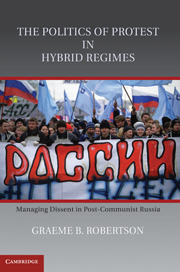Book contents
- Frontmatter
- Contents
- List of Tables
- List of Figures
- Acknowledgments
- Introduction
- 1 Protest and Regimes
- 2 Protest and Regime in Russia
- 3 The Geography of Strikes
- 4 A Time for Trouble
- 5 Elections and the Decline of Protest
- 6 Vladimir Putin and Defeat-Proofing the System
- 7 Protest, Repression, and Order from Below
- 8 Implications for Russia and Elsewhere
- Bibliography
- Appendix 1 Event Protocol
- Appendix 2 Sectoral and Seasonal Strike Patterns
- Appendix 3 A Statistical Approach to Political Relations
- Index
5 - Elections and the Decline of Protest
Published online by Cambridge University Press: 10 January 2011
- Frontmatter
- Contents
- List of Tables
- List of Figures
- Acknowledgments
- Introduction
- 1 Protest and Regimes
- 2 Protest and Regime in Russia
- 3 The Geography of Strikes
- 4 A Time for Trouble
- 5 Elections and the Decline of Protest
- 6 Vladimir Putin and Defeat-Proofing the System
- 7 Protest, Repression, and Order from Below
- 8 Implications for Russia and Elsewhere
- Bibliography
- Appendix 1 Event Protocol
- Appendix 2 Sectoral and Seasonal Strike Patterns
- Appendix 3 A Statistical Approach to Political Relations
- Index
Summary
“Reality is the material world as it is shown on television.”
Viktor Pelevin, Generation P.By the summer of 1999, the Russian elite was deeply divided and in political disarray. President Boris Yeltsin had one year left on his second term in office and no clear successor had yet emerged. In April of that year, then-prime minister Evgenii Primakov had looked the most likely candidate for the presidency, given his success in stemming the effects of the economic crisis and his high approval ratings. But Primakov was both too Soviet in style and too popular for Yeltsin's taste, so Primakov was fired. He was replaced in May by a young security official from St. Petersburg, Sergei Stepashin. But Stepashin struggled to establish his authority, opening his first cabinet meeting by declaring, “In order to avoid various sorts of talk of who is the boss in the government, I state that its chairman (the prime minister) leads the government, and he is responsible for all that happens with the government.” On August 9, Stepashin too was fired.
The catalyst for Stepashin's removal was the announcement that Primakov and Moscow Mayor Iuri Luzhkov had formed a bloc to compete in the December Duma elections. This bloc, called Fatherland–All Russia (OVR), brought Yeltsin's main challengers together with a range of powerful regional governors. The formation of OVR crystallized competition for the succession between Primakov and Luzhkov on one side and Yeltsin's entourage on the other.
- Type
- Chapter
- Information
- The Politics of Protest in Hybrid RegimesManaging Dissent in Post-Communist Russia, pp. 124 - 146Publisher: Cambridge University PressPrint publication year: 2010



